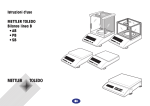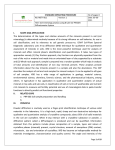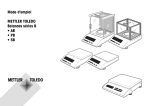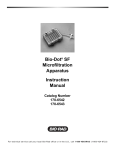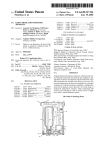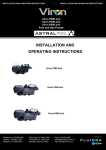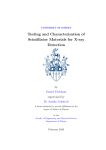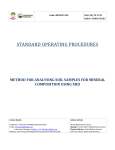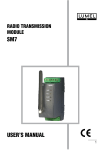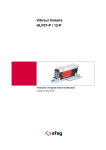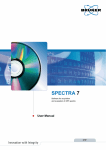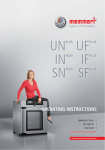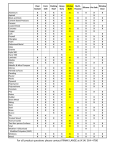Download I. SCOPE AND APPLICATION This is a Standard Operating
Transcript
STANDARD OPERATING PROCEDURE No: METH 012 Version: 1 No of pages 8 Date: 05-062011 Title: Soil Multi-element Analysis using a Bruker S2 Picofox Total X-ray Fluorescence Spectrometer I. SCOPE AND APPLICATION This is a Standard Operating Procedure adopted by the World Agroforestry Centre’s Soil-Plant Spectral Diagnostic Laboratory for total element analysis in soil, plant and liquid samples using the Bruker S2 Picofox Total X-ray Fluorescence Spectrometer. The protocol includes total element profiling in suspended milled soil material, soil-water extracts, suspended milled plant material, and liquids. II. III. RELATED SOPS a. PRP 003 Soil sample preparation and handling b. PRP 004 Plant sample preparation and handling c. PRP 005 Water sample preparation and handling PRINCIPLE An X-ray fluorescence (XRF) method is used for routine, relatively non-destructive chemical analyses of soils, rocks, sediments, fluids and plant materials. The relative ease and low cost of sample preparation, and the stability and ease of use of x-ray spectrometers make this one of the most widely used methods for analysis of major and trace elements. An XRF spectrometer works because when an intense X-ray beam, known as the incident beam, hits an inner shell electron in a sample atom, the electron is removed leaving the atom in an excited state. The missing inner shell electron is replaced by an electron from an outer shell. The energy difference between the inner and outer shell is balanced by the emission of a photon quantum (fluorescence radiation). The energy, and therefore the wavelength, of the x-ray fluorescence radiation is characteristic (finger print) for the different elements. The intensity of the x-ray fluorescence radiation is, as a first approximation, proportional to element concentration. Quantification in total reflection x-ray fluorescence spectroscopy is possible by, known concentration and net intensity of an internal standard element, net intensity of element lines, sensitivity of the instrument for element lines (energy-dependent). IV. a. b. c. d. EQUIPMENT Horizontal Laminar Airflow Cabinet HLF12 outflow .41m/s Laboratory fume hood S2 Picofox,Bruker TXRF spectrometer Memmert oven model UNE 400 temperature 300C to 2500C Page 1 of 13 e. f. g. h. i. j. k. l. m. V. a. b. c. d. e. f. g. h. i. j. k. l. m. n. o. p. q. r. s. t. u. v. w. VWR Ultra sonic water bath, 42KHz sonics Glen Creston McCrone micronising mill IKA MS 3 Vortex mixer,variable speed max 3000rpm Stuart SD 300Temperature controlled hot plate max 3000C Stuart SB 161Magnetic stirrer Micro balance 0.0001 g readability,Mettler AB104-S, min wt 10mg,max 110g Computer with S2 Picofox and R script software Water purification system Aquatron, Automatic water still, A4000D Centrifuge Hettich, Rotina 46, 11000 rpm max MATERIALS Volumetric pipettes (1 – 10 ml, 500 – 5000 µl, 25 – 250 µl, 0.5 – 10 µl) Pyrex beaker (1000 ml, 800ml, 50ml) Micro spatula Volumetric flasks (1000ml, 500 ml, 250ml, 100ml) Sample vials racks PTFE beakers (400ml) Washing cassette Sample carriers Sample cassette Storage container for pure water (10 L) Wash bottles Watch glass Q tip Cleaning tissues (fluff-free) Clear 5 ml capacity sample vials Pipette tips (various) Safety gloves (powder and talcum free) Nitric acid, minimum P.A 10 % (GPR grade) Alkaline cleaning solution (Teepol, 5% RBS 50TM or Decon 90) Acetone, (reagent grade) Silicon solution in isopropanol Triton X-100 standard grade Mono-element standards (normal ICP mono-element standards, which come with a concentration of 1 g/l and a low nitric acid matrix. E.g. "Assurance Standards for ICP-AES and AAS"). x. Multi-element standards. As above. VI. PROCEDURES a. Preparation of reagents and standards. Page 2 of 13 1% by volume aqueous Triton X-100 solution: Using a calibrated pipette, transfer 1ml of Triton X-100 to a labeled 100 ml volumetric flask. Make up to volume using deionised double distilled water. 10 % Cleaning solution: Using a measuring cylinder, transfer 500ml of RBS cleaning solution into a 5000ml volumetric flask. Mix well and make to volume using double distilled water. 10% Nitric acid: Add about 300ml of deionized water into a 500ml volumetric flask. While stirring carefully add 50ml of concentrated Nitric acid into the flask. Mix well and make to volume using deionized double distilled water. Silicon solution in isopropanol e.g. Serva Stock mono-element standards (1000 mg Y/l): ICP stock solutions of pure metal 1000 mg Y/l. Standards must never be prepared or used out of the original bottle. Always separate an aliquot and use it for preparation. A mono-element standard can also be used as internal working standard. Stock mono-element standards (1000 mg Se/l): ICP stock solutions of pure metal 1000 mg Se/l. Standards must never be prepared or used out of the original bottle. Always separate an aliquot and use it for preparation. A mono-element standard can also be used as internal working standard. Stock mono-element standards (1000 mg Sc/l): ICP stock solutions of pure metal 1000 mg Sc/l. Standards must never be prepared or used out of the original bottle. Always separate an aliquot and use it for preparation. A mono-element standard can also be used as internal working standard. 1mg/l Ga, Sc, Pb and Y multi-element standard: Transfer 0.25ml of the 1000mg/l of Ga, Sc, Pb and Y stock mono-element standards into a 250ml volumetric flask and make to volume with ultra-pure water. The multi-element standard is stored on a quartz disc carrier for long-term reference. This multi-element standard is also used for detector test, total counts and for quality control. Select Gallium for gain correction in this case. b. Sample processing Soils: Air-dried 2-mm sieved soils and minerals are subsampled to 10 g by coning and quartering. The 10 g subsample is oven-dried at 40°C and then ground to a fine powder using a mortar and pestle. Further milling to between 20- 53 µm is done using a micronizing mill. The sample is placed in a labeled zip-lock polythene bag or glass vial for transfer to the TXRF laboratory. Plants: Plant material is oven-dried at 60° C and then ground to pass a 1-mm sieve using a Wiley or Cyclotech mill. For bulky samples, a 10 g subsample is obtained by coning and quartering. The 10 g subsample is oven-dried again at 40° C and then ground to a fine powder. Further milling to between 20-53 µm particle sizes is done using a micronizing mill. The sample is placed in a labeled zip-lock polythene bag or glass vial for transfer to the TXRF laboratory. Page 3 of 13 Liquid: Liquid samples are well shaken in their original containers and then a 10 ml subsample pipetted from mid-height of the liquid column into a clean, labeled glass vial for transfer to the TXRF laboratory. Fruit juices can be diluted to prevent formation of a thick film. E.g. a dilution factor of 2 to 5 is suitable for orange juice. Different dilutions can be tested to find an optimal peak to scattering background ratio. The sample type determines the weight range when weighing. c. Cleaning and preparation of sample carriers All tasks connected to cleaning of sample carriers are to be done under a laboratory fume hood. Mechanically clean/wipe sample carrier with fluff free tissue paper soaked in acetone. Mount the sample carriers onto the washing cassette Transfer the washing cassette into a 1000 ml glass beaker containing hot cleaning solution (e.g. RBS 50 diluted to ratio 5:50).The glass beaker should have enough solution to cover the sample carriers on washing cassette. Heat for five minutes on a hotplate set to 800C temperature prior. The solution must not boil. Thoroughly rinse the sample carriers with deionized double distilled water. Transfer the washing cassettes into 1000ml glass beaker filled with 10% nitric acid Heat for two hours on a hot plate previously set to 80 0C temperature in a chemical fume cupboard. The acid should not boil. The glass beaker should have enough acid to cover the sample carriers. The beaker should be covered with a watch glass. Thoroughly rinse the sample carriers with deionized double distilled water. Transfer the sample carrier on the washing cassette into a 1000 ml glass beaker containing hot distilled water/or in hot water bath. Heat for five minutes on a hotplate set to 800C in advance. The water should not boil. Thoroughly rinse the sample carriers with ultra-pure water. Dry the sample carriers in a drying oven at 800C for thirty minutes Carefully wipe the sample carriers with tissue paper soaked in acetone. Apply 10 µl silicon solution at the center of the sample carriers. Dry the sample carriers in a drying oven at 800C for thirty minutes. Run a blank test measurement. Place the cleaned carriers in a cassette and run them for 120s each. As a rule of thumb, no elemental peak apart from Si (quartz carrier blank signal), Ar (air) and Mo (tube) should appear with intensity higher than the ArKß-line) The preparation of samples carriers, suspension of samples and transfer of sample materials to sample carriers should be done in the TXRF laboratory inside a horizontal laminar flow cabinet to ensure a contamination-free working environment. This is Page 4 of 13 particularly important for detection of elements at part-per-billion concentrations. Samples are prepared in a thin layer to reduce matrix effects. Disposable sample containers and pipette tips are used. d. Analysis of samples i. Soil sample – suspended powder Place a labeled vial in a microbalance and tare its weight. Transfer approximately 40 – 50 mg of the sample into the vial. Record the actual weight to nearest 0.01 mg. Add 2.5ml of an aqueous Triton X100 solution. For accurate determination of light elements only, transfer 40 µl of 1000 mg/l Se internal standard solution into the suspension using a calibrated pipette. Mix well to make a homogenous solution using the agitator. Place the samples in a water bath and apply sonics for 15 minutes Mix well immediately after sonication and transfer 10 µl of the suspension using a calibrated pipette onto the center of the siliconized sample carrier. Dry for about ten minutes on hot plate set at 500C. A thin film or layer or suspension of powder is formed. Assemble the sample carriers onto the sample cassette. The first position should be reserved for the 1 mg/l mono-element standard carrier for gain correction. The ICRAF SOIL III method is used for multi-element measurement. Note that the ICRAF SOIL III method uses reference spectra from the Reference soil and sediments directory, as these have been developed especially for soils. Refer to Annex 1 for setting up methods. ii. Soil water extract The soil water suspension from i above is treated as below:Centrifuge for 10 minutes at 4000 rpm until a clear supernatant is achieved. Transfer 10 µl of the clear supernatant using a calibrated pipette onto the center of the siliconized sample carrier. Dry for about ten minutes on hot plate set at 500C. Assemble the sample carriers onto the sample cassette. The first position is reserved for the 1mg/l Arsenic mono-element standard carrier for gain correction. The SOIL-WATER method is used for multi-element measurement. Note that the SOILWATER method uses reference spectra from the standard reference folder. iii. Plant sample – suspended powder Place a labeled vial in a microbalance and tare its weight. Transfer approximately 40 – 50 mg of the sample into the vial. Record the actual weight to nearest 0.01 mg. Add 2.5ml of an aqueous Triton X100 solution. Page 5 of 13 For accurate determination of light elements only, transfer 40 µl of 1000 mg/l Sc internal standard solution into the suspension using a calibrated pipette. For accurate determination of heavier elements, in addition transfer 10 µl of 1000mg/l Y single element internal standard into the suspension using a calibrated pipette. Mix well to make a homogenous solution using the agitator. Place the samples in a water bath and apply sonics for 15 minutes Mix well immediately after sonication and then transfer 10 µl of the suspension using a calibrated pipette onto the center of the siliconized sample carrier. Dry for about ten minutes on hot plate set at 500C. A thin film or layer or suspension of powder is formed. The ICRAF PLANT I method is used for multi element measurement. Note that the ICRAF PLANT I method uses the Reference plant material (not the soil reference spectra). For accurate determination of light elements, run the job using the Sc internal standard selected. For accurate determination of heavy elements, run the job a second time with Y selected as the internal standard. iv. Liquid sample – neat Pipette 1000 µl of the sample into a labeled vial. For accurate determination of light elements only, transfer 40 µl of 100 mg/l Sc single element standard into the liquid sample. For determination of heavier elements, in addition transfer10 µl of 100 mg/l Y single element internal standard using a calibrated pipette into the liquid sample. Note the 10 times dilution of the standards compared with the soil and plant methods. Mix well to make a homogenous solution using the agitator. Transfer 10 µl of the solution using a calibrated pipette onto the center of the siliconized sample carrier. Dry for about ten minutes on hot plate set at 500C. A thin film is formed. The LIQUID method is used for multi-element measurement. Note that the LIQUID method uses the standard reference spectra (not the soil reference spectra). For accurate determination of light elements, run the job using the Sc internal standard selected. For accurate determination of heavy elements, run the job a second time with Y selected as the internal standard. v. Measurement Check and make sure that the mains power supply and the data lines of the spectrometer and the control computer are properly connected. Switch on the spectrometer using the key switch on the front panel. Green power light will illuminate showing good power connection. Page 6 of 13 Switch on the control computer and then double click the icon ‘PICOFOX’ to start the operating system. Enter the security password ‘TEST’. Select ‘Cancel’ in the next dialogue to access the measurement software. Carefully introduce the sample cassette into the sample changer compartment. Prepare a measurement job by filling the following information: o Sample name – ICRAF sample identification number. Enter the first sample starting from the first row. o Spectrum name – Use automatically generated name o ID number – optional information; can leave blank o Disc – disc number engraved on sample carrier o Pos – Sample carrier position on cassette. Note that the first sample will be in Position 2. o Time/s – Measurement time in seconds: 1000 for soil or soil-water, 600 for plant (unless need Selenium), 1000 for liquid. o Method – select from dropdown menu: ICRAF SOIL III ; SOIL-WATER; ICRAF PLANT I ; or LIQUID (select as appropriate). o Quant type – solid or liquid (select from dropdown) o Standard element– Se, Sc for light elements, Y for heavy elements. o Standard concentration– Leave blank for solid; enter 1000, 000µg/l for soil-water extract or 100,000µg/l for liquid. o Unit – units of standard concentration (also the units used for reporting): mg/kg for solid; µg/l for liquid (select from dropdown). o Sample amount – enter exact sample amount in mg for solid; leave blank for liquid. o Standard amount – amount of internal standard added to sample suspension – 40 µg (Se) for soil; 40 µg (Sc) for light elements in plant and 10 µg (Y) for heavy elements;; leave blank for soil-water or liquid. o Blank value – leave blank o Comments etc. o Highlight the first row and select the gain correction button. The gain correction will automatically be entered in Row 1 as the first sample carrier position. You should have already specified the element to be used for gain correction and the measurement time in the Gain Correction routine under the Devices menu. Check that the element selected for gain correction matches with the element present on the sample carrier at Position 1. This should normally be Arsenic using the mono-element standard sample carrier. o Save the measurement job. Perform reference drive of the sample changer. Reference drive is selected by using the function ‘Reference’ in the ‘Sample Changer’ tool. The display ‘SAMPLE’ in the front panel will illuminate. Page 7 of 13 Switch on the x-ray tube by selecting the high voltage tool on the menu bar. Orange X-ray light will illuminate. If the x-ray was switched off for more than 12 hours, a warm-up is automatically performed. The x-ray tube and all components of the TXRF beam guide and the electronics require about 45 minutes for establishing a thermal balance. During this period the x-ray symbol in the toolbar will be blinking. The x-ray symbol stops blinking when the operating values are achieved. Start instrument operation by selecting ‘Start’. Multi-element analysis of samples can now be done. The ICRAF methods allow automatic processing of gain correction, multi-element measurement and the evaluation of spectra after the end of the measurement. All completed measurements and spectra are saved in the project file. Refer to Annex 2 for quantification methods. e. Spectral Quality control diagnostics. Several observations on the acquired spectra should be routinely performed to check data quality. Check to see if the concentrations are realistic for the type of sample. It is useful to make a table of upper and lower limits of elements found in soils based on experience. Internal standard of known concentration is added into every sample and is used for the quantification and quality management of the instrument. Plot each spectrum from the job. Check for double peaks, or other anomalies. Spectroscopic resolution is checked by measuring Mn Kα then checking the Full width at Half Maximum value against the initial file values at particular count values. Mn Kα lines are used as reference for spectrum development. Every fresh batch of 1% Triton X-100solution is tested to check for contamination. The solution is pipetted onto a sample carrier and run as a sample. At the same time as the above check, include two cleaned blank quartz sample carriers to check for contamination in the cleaning procedures. Use a 10-minute measurement time. Save the results. f. Instrument Quality control Optimize detection. This is performed by checking the incident angle by measuring a clean siliconized disc for 120 seconds. The ratio of Silicon peak to that of Argon should be between 2-2.5 to 1.If angles are lower, then you may loose detection and hence sensitivity. Detection test should be done monthly. Gain correction includes fine readjustment of spectroscopic amplification using a known signal of 1 mg/l mono-element standard. These drifts occur after long operation of the instrument, which makes fluorescence lines in the spectrum to be misallocated in the atomic data library. Gain correction is executed daily automatically during the application of the job function. Page 8 of 13 Instrument sensitivity is tested by measuring a 1ng Ni sample. Fluorescence intensity, time, count rates and tube current measured are recorded then compared with initial calibration file. Maladjustment of beam guide and deterioration of X-ray tube can affect sensitivity. However this test only needs to be performed during troubleshooting. Sensitivity check should be performed monthly. Accuracy of quantification is a surveillance of the complete analytical procedure. Using 1mg/l of known mono-element reference perform a gain correction (on As). Record the count rate (e.g. 100,000 counts/sec) for the reference disk using a 30-second measurement time. This procedure is also used as a detector test. Store the standard sample carrier in a desiccator for long-term storage. g. Regular instrument check points. Rate counts when there is no sample disc in measuring position during measurement should be between 200 to 220. Ratio of Silicon and Argon peaks when checking incident angles using a clean unsiliconized disc should be between 2 -2.5 The value after calculation during spectronic resolution check using Mn-standard should be below 150keV Measured detection limit when performing sensitivity check using 1 ng Ni must always be below 2 pg. During sensitivity check measurement using 1 ng Ni, the pulse values on the graph should be greater than corresponding time values. This will show that sensitivity is fine. h. Switching off the instrument Finish the measurement of samples. Remove any sample carrier from the measurement position by selecting the command Remove in the dialogue Sample changer. Remove sample cassette from instrument. Switch off high voltage Close the measurement programme and switch off the computer. Switch off the spectrometer using the key switch. VII. CALCULATIONS The software application used to run the analyzer (Spectra 5.3 ) automatically stores raw spectra and spectral data acquired during an analysis in comma-delimited ASCII text format for later computation, display, and printing.R software is now used to convert the ASCII text files to excel files which later stored in four pre-created subfolders within a folder ‘Raw Spectra’ and labelled as ;1) Soil; 2)Soil-water extracts ;3)Plants ;4)Liquid, to represent the different sample materials scanned. This structure is displayed in the figure below. Page 9 of 13 VIII. QUALITY ASSURANCE/QUALITYCONTROL Reference material: Katumani soil reference material is included in every run of soil sample analysis. Various standard plant reference materials are included in every plant analysis run. Blanks: Scanning of clean discs to confirm purity. An analysis of 1% Triton X-100 without sample to check for contamination. Calibration: A gain correction is done for every set of samples analysed. Merck multielement standard is measured weekly for accuracy of quantification. Mn standard is measured monthly to monitor spectronic resolution. Sensitivity is monitored monthly by measurement of 1-ng-Ni standard sample. Triplicates: All samples and standards are measured in triplicate. IX. DATA VALIDATION a. Data Review Check the sample data and QC data to verify that the data to be reported is based on acceptable analyses and meet acceptable limits. Verify that all standard, reagents, and quality control samples have been entered into the appropriate logs. Page 10 of 13 Verify that the results have been entered into the appropriate spread sheet and proof read. Place data in the laboratory database. b. Supervisor Review Check the sample data and QC data to verify that the data to be reported is based on acceptable analyses and meet acceptable limits Verify that the results have been entered into the appropriate spreadsheets correctly. If any errors are found, return data to analytical chemist for corrections. Ensure documentation on printouts (i.e., initials, date, label) is complete. Authorize reporting. X. HEALTH AND SAFETY Personal protection: Safety glasses and protective gloves are recommended whenever reagents or samples are handled. For other precautions and safety procedures, consult the Material Safety Data Sheets (MSDS) for each chemical used. Electrical hazards: Electrical systems must conform to the ICRAF standards. Shock hazards exist inside the instruments. Only an authorized service representative or an individual with training in electronic repair should remove panels or circuit boards where voltages are greater than 20 V. The instruments require a third-wire protective grounding conductor. Three-to-two wire adapters are unsafe for these instruments. Chemical hazards: Hydrochloric acid is a strong acid used to remove inorganic carbon from sediment samples. Gloves should be worn when handling strong acids. If contact occurs, the affected area should be rinsed thoroughly with water. Gloves should be worn when handling acids and, whenever possible, manipulations should be conducted in a fume hood. Wastes accumulated during the operation and other cleaning operations should be stored in a capped glass bottle and arrangements made for its safe disposal. Radiation protection: To ensure maximum radiation protection, the S2 Picofox must be operated with the control software ‘SPECTRA’ included in delivery.Only this software guarantees the compliance of the X ray source operation parameters as certified according to anti-radiation precautions. Further ,safety rules and technical installation and information provided in the user manual should adhered to explicitly. XI. REFERENCES a) ICRAF Soil reception manual b) S2 PICOFOX TM User Manual c) ICRAF Laboratory Methods For Soil and Plants XII. APPENDIX Appendix 1: Setting up a Picofox Analyze Method Page 11 of 13 Note: Underlined settings are the only settings that normally need to be changed when setting up a new method based on an existing method. Naming: o Add to create a new method: type a new name and then ‘Add’. The method will adopt the settings from whatever method was being displayed when “Adding’. These can then be edited. Press OK to save. o Replace to edit an existing method. Display the method to be edited, make the changes, and then press Replace. o Remove to delete a method Main sheet o Add comments on adjustments to reference spectra, etc. o Automatic evaluation: Checked Corrections o Escape: checked o Shelf: unchecked o Background: checked o Cycles: 10 Identification o Method: Preset list o Elements for identification: check in table o Get Elements: Do not press this. It adds elements from a displayed spectrum window. Deconvolution o Method: Super Bayes (optimized fit) o Max stripping cycles: 1000 o Stepwidth: 50 o Path to reference files (superbayes): For suspended soil, use the ‘Reference soil and sediments,for plant use ‘Reference plant material’ folder, for all other methods use the ‘Reference’ folder. Quantification o Calculate concentration: checked o Calibration file: The paths for soil suspension should be to ‘Soil calibration II’, for plants should be to’ Plants calibration I’. For all others paths should be to‘PICOFOX_Mo_Nairobi.txr’. o Excluded elements: For soil Si, Ar, Mo, Yb, Ta, Tl, Th; For Plants Si, Ar,Yb,Er, Mo Annex 2: Quantification with internal standard The formula below is used to calculate quantification where an internal standard is introduced in sample solution. Here it is important that this element was not present in original sample. This quantification type is ideal for liquid samples and suspensions. CIS .Ni . SIS Ci = NIS . Si Page 12 of 13 Ni =net pulse number within the measurement spectrumSi of the element to be analysed. NIS=net pulse number within the measurement spectrum of the internal standard SI=relative sensitivity of the element i SIS=relative sensitivity of internal standard element Ci=concentration of the element to be analyzed CIS=concentration of the internal standard Lowest limits of detection The minimal detectable concentration of an element within a sample, allows the decision about presence or absence of an element within a sample LLDi= 3.Ci . NBG Ni LLDi=lowest limit of detection, detection limit of an element i Ci = concentration of the element i Ni = area of the fluorescence peak in counts NBG = background area subjacent the fluorescence peak. Annex 3. Re-Evaluating Spectra The below instructions apply in the case that spectra need to be re-evaluated, for instance using different units or reference spectra. 1. Open the spectrum in the spectrum window. 2. Clear the periodic table elements list (Analyze, Periodic Table, Clear All) to prevent this from over-riding the Methods element list. 3. Check the details at the top are correct (Quantification type; Standard element, Unit for reporting; Sample amount; Standard amount). 4. Click on the Evaluate button. 5. Save the re-evaluated spectrum in a new project or under a different name. Note that currently only one spectrum at a time can be re-evaluated. Page 13 of 13













